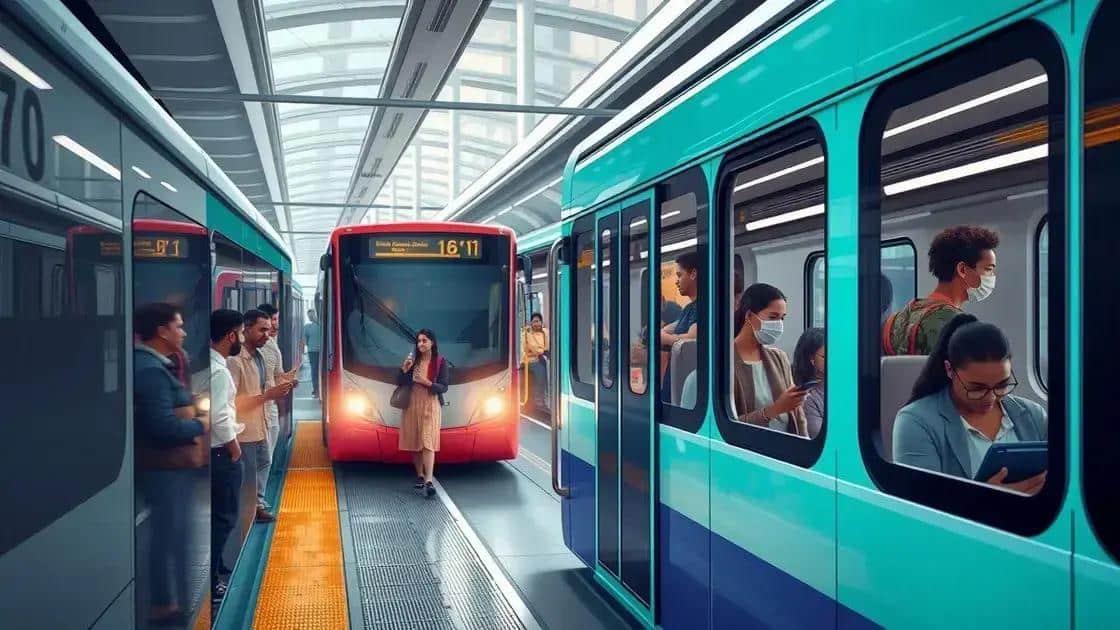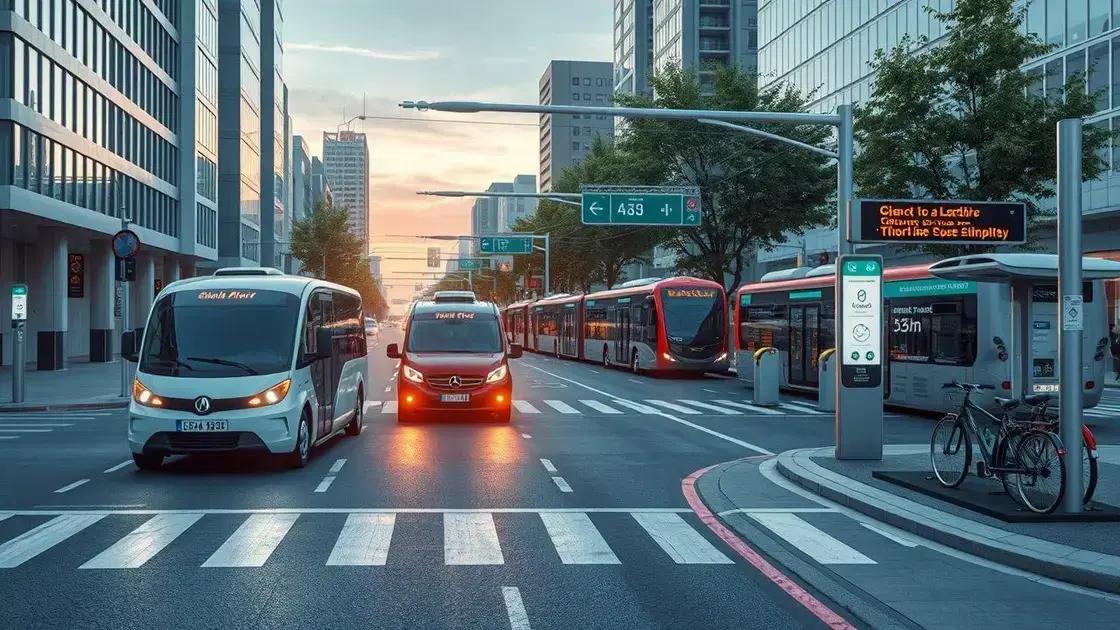Culture transport infrastructure news: what to expect next

Transport culture integration involves blending sustainability, technology, and community engagement to create efficient and user-friendly urban mobility solutions, ensuring a seamless transition between various transport modes.
Culture transport infrastructure news is evolving rapidly, influenced by shifts in urban living and technology. Have you ever considered how these changes shape your daily commute? Let’s dive deeper into what the future holds.
Understanding the current trends in transport infrastructure
Understanding the current trends in transport infrastructure is crucial as cities evolve to meet modern demands. This section explores how these developments impact our daily lives.
One of the most prominent trends is the integration of sustainable practices. Cities are focusing on reducing carbon footprints, promoting energy-efficient transportation systems, and implementing green spaces within urban designs.
Key Features of Modern Transport Infrastructure
Modern transport systems are becoming more user-friendly and connected. Here are some key features:
- Enhanced public transit options, including electric buses and bike-sharing systems.
- Smart traffic management using IoT technology to improve flow.
- Accessible infrastructure for people with disabilities.
- Walkable city designs encouraging pedestrian traffic.
In addition, the rise of smart cities emphasizes data-driven decision-making. Using real-time data enhances efficiency and safety for commuters. How often do we see traffic lights adapting to live traffic conditions? This is just one example of how innovative solutions are reshaping our urban landscapes.
Technology’s Role in Transport Innovation
Technology is a game-changer in transport infrastructure. Automated vehicles and drone deliveries are on the rise, promising faster service delivery. The move towards electric vehicles is not just a trend; it’s a shift towards cleaner air.
Moreover, mobile apps are transforming how we plan our journeys. With just a few taps, commuters can access real-time information on transit schedules, traffic conditions, and alternative routes.
As these trends continue to develop, it’s clear that transport infrastructure is not just about moving people from one place to another. It’s about integrating cultural elements, enhancing sustainability, and making cities more livable.
Impact of culture on transportation development
The impact of culture on transportation development is significant and multifaceted. Culture shapes how we design our transport systems and influences the way people interact with them.
Throughout history, various cultures have prioritized different transportation methods. In many European cities, bicycles are a common sight due to cultural attitudes favoring sustainability and health. This trend promotes the development of extensive bike lanes, enhancing urban mobility.
Cultural Influences on Urban Planning
Key cultural factors play a role in shaping transportation infrastructure. Here are some examples:
- Public transport options in Asian countries focus on efficiency and accessibility.
- Walkable urban spaces in European cities encourage social interaction.
- North American suburbs often prioritize car travel, resulting in a different transport landscape.
Each region’s cultural preferences guide the creation and improvement of transport networks. Understanding these influences can help policymakers design better systems tailored to local communities.
Community Engagement in Transport Projects
Community culture significantly impacts transportation projects. Involving locals in the planning process fosters a sense of ownership. When people feel connected to their transport systems, they advocate for sustainable practices and improvements.
For example, cities that embrace participatory design often see success in implementing bike-sharing programs or affordable public transit. These initiatives resonate with the community’s values and needs.
In sum, culture and transportation development are intertwined. As cities evolve, recognizing cultural influences will guide future improvements and innovations.
Innovative solutions in transport technology

Innovative solutions in transport technology are transforming how we navigate our cities. As technology advances, it plays a crucial role in enhancing transportation efficiency and reducing environmental impacts.
One major innovation is the development of autonomous vehicles. These self-driving cars promise to improve road safety and reduce traffic congestion. They rely on advanced sensors and algorithms to navigate and interact with their surroundings.
Smart Transportation Systems
Another key area in transport technology is the implementation of smart transportation systems. These systems utilize data analytics and real-time information to optimize traffic flow. By connecting various modes of transport, cities can create more efficient and responsive networks.
- Real-time tracking of public transport for improved reliability.
- Adaptive traffic signals that change based on current traffic conditions.
- Integration of mobile apps for users to plan their journeys more effectively.
These innovations help create a seamless experience for commuters. By making transportation systems more adaptable, cities can better serve their populations and reduce wait times.
Electric and Sustainable Transport Solutions
The rise of electric vehicles is another significant development in transport technology. With growing concerns about climate change, many cities are promoting electric public transport options, such as buses and trams. This shift not only reduces greenhouse gas emissions but also improves air quality.
In addition to electric vehicles, many cities are investing in infrastructure that supports sustainable transportation options. Bike lanes, pedestrian pathways, and car-sharing programs are becoming increasingly popular. These initiatives encourage people to opt for greener modes of travel.
As we explore innovative solutions in transport technology, it’s clear that the future of transportation will be defined by efficiency, sustainability, and user convenience.
Case studies from global cities
Examining case studies from global cities reveals valuable insights into effective transport solutions. Cities worldwide are tackling similar challenges with distinct approaches, showcasing innovation and adaptability.
For instance, in Copenhagen, the focus on cycling infrastructure has led to a significant increase in bike usage. The city has invested in extensive bike lanes and safety measures, encouraging residents to commute by bike, which decreases traffic congestion and pollution.
Successful Urban Transport Models
Another notable example comes from Singapore, where a comprehensive public transport system, including trains and buses, operates efficiently. This integrated transport system relies on technology to provide real-time updates to commuters, ensuring timely travel.
- Singapore’s smart card system allows for seamless travel across different transport modes.
- The city implements strict regulations on car ownership to promote public transport use.
- Innovative traffic management systems minimize congestion and improve travel times.
Similarly, Amsterdam has become a model for sustainable transport through its commitment to public transit and cycling. The city’s design is centered around pedestrian-friendly spaces and extensive bike routes, promoting a healthy lifestyle and lowering carbon emissions.
Lessons from Global Comparisons
These case studies highlight the importance of considering cultural aspects when developing transport solutions. Each city adapts its infrastructure to fit the needs and behaviors of its residents. Learning from these examples can inspire other cities to adopt similar strategies.
As urban areas continue to grow, understanding what works in different contexts will be crucial. The experiences of cities like Copenhagen, Singapore, and Amsterdam provide a roadmap for improving transport systems worldwide.
Future predictions for transport culture integration
Future predictions for transport culture integration suggest a shift towards more cohesive and sustainable urban mobility solutions. As cities grow and evolve, the blending of transportation systems and cultural practices will become increasingly important.
One key prediction is the rise of multimodal transport options. This concept encourages users to switch between different forms of transport easily. For example, people may use bikes for short distances, public transit for longer commutes, and ride-sharing services in between. Integrating these options will enhance flexibility and reduce reliance on single-occupancy vehicles.
Emphasis on Sustainability
As environmental concerns rise, cities will likely place a stronger emphasis on sustainable transport solutions. The increased use of renewable energy for public transport systems is expected. Electric buses and trams could become the standard in many metropolitan areas, dramatically cutting emissions and improving air quality.
- Investment in charging infrastructure for electric vehicles.
- Promotion of walking and cycling through dedicated lanes.
- Creation of pedestrian-friendly spaces that encourage community interaction.
Additionally, public awareness campaigns could play a vital role in shifting cultural attitudes toward sustainability in transport. Education about the benefits of using public transport and non-motorized options will be crucial.
Technological Integration
Technology will also be a significant factor in the integration of transport cultures. The expansion of smart city technologies will facilitate better data collection and analysis, leading to more efficient transport planning. For instance, real-time data can inform users about congestion, delays, and alternative routes, making travel more manageable.
As autonomous vehicles become more commonplace, they could further influence transport culture by providing seamless and user-friendly options that cater to various needs. Areas that embrace innovative transport solutions will likely see significant changes in how communities interact with their transport systems.
These predictions indicate a future where transport culture is not only about moving from point A to B. Instead, it will involve creating a cohesive and sustainable framework that supports diverse ways of travel.
FAQ – Frequently Asked Questions about Transport Culture Integration
What are some key trends in transport culture integration?
Key trends include the rise of multimodal transport options, increased focus on sustainability, and the use of technology to optimize mobility.
How can cities encourage the use of sustainable transport?
Cities can promote sustainable transport by investing in bike lanes, electric public transport, and creating pedestrian-friendly spaces.
What role does technology play in the future of transport?
Technology enhances transport systems by providing real-time data, improving traffic management, and integrating various transport modes for seamless travel.
Why is community engagement important in transport projects?
Engaging the community helps ensure that transport solutions meet the needs of residents, fostering a sense of ownership and encouraging public support.





